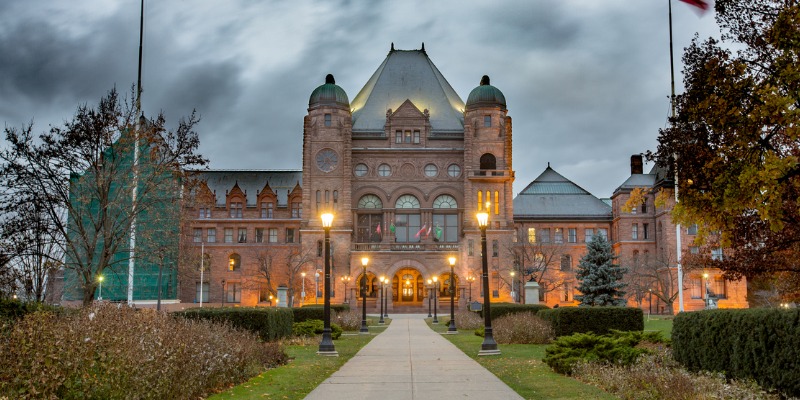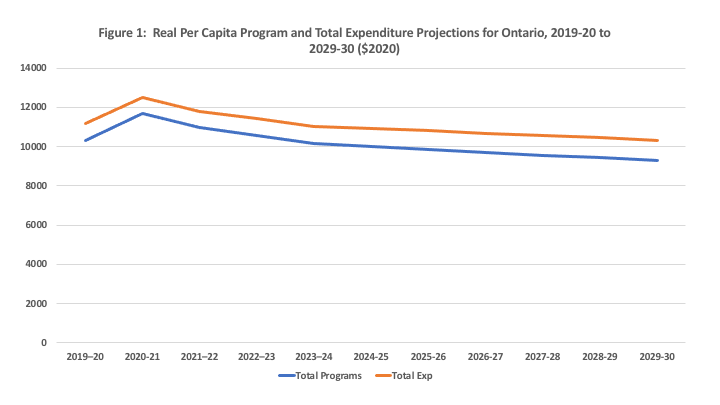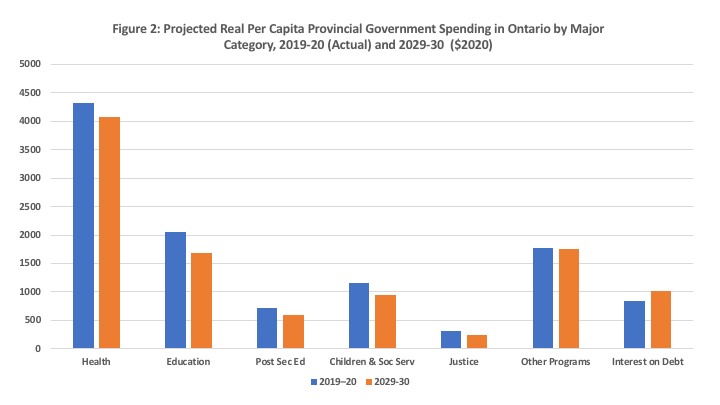Government debt interest costs will crowd out essential spending in Ontario

The Ford government’s 2021 spring budget was notable in that it included not only medium-term fiscal projections but also a fiscal recovery plan that provided numbers until fiscal year 2029-30. While one might be tempted to throw up one’s hand and simply quip that the world should last so long, it is an attempt to chart Ontario’s fiscal future.
The numbers are interesting not so much with respect to what they say about future fiscal balance but what they imply about government spending in Ontario and the inconsistency between what the government says it wants to do and what the numbers show.
The recovery plan’s core assumption is that over the decade of the 2020s, revenue will grow faster than spending. Total revenue growth is projected at 3.9 per cent annually while program spending is projected to grow at 2.1 per cent. From 2019-20 to 2029-30, program spending in Ontario goes from $152.3 billion to $187.0 billion, total expenditures rise from $164.8 billion to $207.6 billion and total revenues rise from $156.1 billion to $210.1 billion.
In percentage terms, over this same period, program spending rises 23 per cent, total expenditure 26 per cent and total revenues 35 per cent. In other words, it will take at least a decade for Ontario to balance its budget in the wake of the twin COVID-19 fiscal spikes of increasing spending and falling revenues over the 2020 to 2021 period.
The increases in spending and revenue over the coming decade appear to be substantial, but the spending is interesting because once you account for population growth and inflation, real per-capita spending in Ontario is poised to decline substantially. Assuming inflation at 2 per cent annually and taking the medium or reference population projections from Ontario’s Ministry of Finance, the first chart below shows that once the COVID-19 spike dissipates, real per-capita provincial government spending in Ontario can be expected to fall below actual 2019-20 spending. Indeed, total real per-capita spending over this 10-year period drops nearly 8 per cent.

For real per-capita spending by broad category, the results are quite intriguing. The second chart reveals that spending drops in all of these categories except one—interest on the provincial debt. Health care drops by about 6 per cent, education by 18 per cent, post-secondary education by 18 per cent, children and social services by 18 per cent, justice by 22 per cent, and all other programs by 1 per cent. Interest on the debt? It will rise by 21 per cent.

Despite the renewed hope that revenues will rise substantially faster than expenditures, the end result of decades of deficits and debt accumulation are finally coming home to roost as debt interest crowds out spending on some of the things people need government to do. Ontarians will pay more and get less for years to come.
Even more interesting is that despite the dire implications of these numbers, the Ontario government’s future expenditure plans seem at odds with this reality. Case in point—health care. According to this interpretation of the numbers, provincial government health-care spending (per person, in 2020 dollars) will fall from $4,315 in 2019-20 to $4,072 by 2029-30. Yet, when it comes to health care, the Ontario government wants to increase hours of daily care per resident in long-term care homes, add 9,000 more personal support workers, and 30,000 new long-term care beds.
Moreover, the Financial Accountability Office of Ontario now predicts it will take years to address the backlog of surgeries in Ontario that were delayed by the pandemic. Indeed, the elective surgery backlog will reach 419,200 procedures and the diagnostic backlog will reach nearly 2.5 million procedures by the end of September 2021.
So, we have in the case of health the paradox of an irresistible spending force meeting what seems to be an immovable budgetary object. There may indeed be other paradoxes that will emerge in the other spending categories. Perhaps the government expects that budgets will be more flexible by shifting the target for budget balance into the subsequent decade? However, this would ensure that debt interest will continue to be Ontario’s fastest-growing expenditure category.
Such a future does not bode particularly well for anyone getting old and needing more health care or families with young children in Ontario’s school system.

